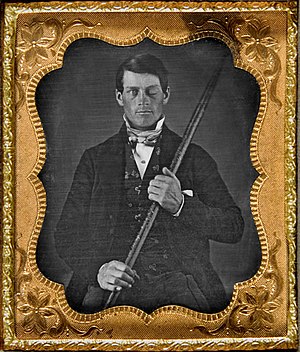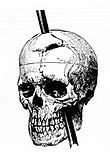Welcome to DU!
The truly grassroots left-of-center political community where regular people, not algorithms, drive the discussions and set the standards.
Join the community:
Create a free account
Support DU (and get rid of ads!):
Become a Star Member
Latest Breaking News
Editorials & Other Articles
General Discussion
The DU Lounge
All Forums
Issue Forums
Culture Forums
Alliance Forums
Region Forums
Support Forums
Help & Search
American History
Related: About this forumOn this day, September 13, 1848, Phineas Gage had a large iron rod driven through his head.
Phineas Gage

Phineas Gage Cased Daguerreotype
Phineas P. Gage (1823–1860) was an American railroad construction foreman remembered for his improbable survival of an accident in which a large iron rod was driven completely through his head, destroying much of his brain's left frontal lobe, and for that injury's reported effects on his personality and behavior over the remaining 12 years of his life—effects sufficiently profound (for a time at least) that friends saw him as "no longer Gage".

The iron's path, per {town doctor John Martyn} Harlow
Long known as the "American Crowbar Case"—once termed "the case which more than all others is calculated to excite our wonder, impair the value of prognosis, and even to subvert our physiological doctrines" —Phineas Gage influenced 19th-century discussion about the mind and brain, particularly debate on cerebral localization, and was perhaps the first case to suggest the brain's role in determining personality, and that damage to specific parts of the brain might induce specific personality changes.
{snip}
Accident

Gage's mouth was open at the moment of the explosion, and his skull temporarily "hinged" open as the iron passed through, then was pulled closed by the resilience of soft tissues once the iron had exited through the top of Gage's head.
On September 13, 1848, Gage was directing a work gang blasting rock while preparing the roadbed for the Rutland & Burlington Railroad south of the town of Cavendish, Vermont. Setting a blast entailed boring a hole deep into an outcrop of rock; adding blasting powder and a fuse; then using the tamping iron to pack ( "tamp" ) sand, clay, or other inert material into the hole above the powder.
As Gage was doing this around 4:30 p.m., his attention was attracted by his men working behind him. Looking over his right shoulder, and inadvertently bringing his head into line with the blast hole, Gage opened his mouth to speak; in that same instant the tamping iron sparked against the rock and (possibly because the sand had been omitted) the powder exploded. Rocketed from the hole, the tamping iron—1 1⁄4 inches (3.2 cm) in diameter, three feet seven inches (1.1 m) long, and weighing 13 1⁄4 pounds (6.0 kg)—entered the left side of Gage's face in an upward direction, just forward of the angle of the lower jaw. Continuing upward outside the upper jaw and possibly fracturing the cheekbone, it passed behind the left eye, through the left side of the brain, then completely out the top of the skull through the frontal bone.
Despite 19th-century references to Gage as the "American Crowbar Case", his tamping iron did not have the bend or claw sometimes associated with the term crowbar; rather, it was simply a pointed cylinder something like a javelin, round and fairly smooth:
The tamping iron landed point-first some 80 feet (25 m) away, "smeared with blood and brain".
Gage was thrown onto his back and gave some brief convulsions of the arms and legs, but spoke within a few minutes, walked with little assistance, and sat upright in an oxcart for the 3⁄4-mile (1.2 km) ride to his lodgings in town. About 30 minutes after the accident physician Edward H. Williams, finding Gage sitting in a chair outside the hotel, was greeted with "one of the great understatements of medical history":
Harlow took charge of the case around 6 p.m.:
{snip}

"Disfigured yet still handsome". Note ptosis of the left eye and scar on forehead.
{snip}

Phineas Gage Cased Daguerreotype
Phineas P. Gage (1823–1860) was an American railroad construction foreman remembered for his improbable survival of an accident in which a large iron rod was driven completely through his head, destroying much of his brain's left frontal lobe, and for that injury's reported effects on his personality and behavior over the remaining 12 years of his life—effects sufficiently profound (for a time at least) that friends saw him as "no longer Gage".

The iron's path, per {town doctor John Martyn} Harlow
Long known as the "American Crowbar Case"—once termed "the case which more than all others is calculated to excite our wonder, impair the value of prognosis, and even to subvert our physiological doctrines" —Phineas Gage influenced 19th-century discussion about the mind and brain, particularly debate on cerebral localization, and was perhaps the first case to suggest the brain's role in determining personality, and that damage to specific parts of the brain might induce specific personality changes.
{snip}
Accident

Gage's mouth was open at the moment of the explosion, and his skull temporarily "hinged" open as the iron passed through, then was pulled closed by the resilience of soft tissues once the iron had exited through the top of Gage's head.
On September 13, 1848, Gage was directing a work gang blasting rock while preparing the roadbed for the Rutland & Burlington Railroad south of the town of Cavendish, Vermont. Setting a blast entailed boring a hole deep into an outcrop of rock; adding blasting powder and a fuse; then using the tamping iron to pack ( "tamp" ) sand, clay, or other inert material into the hole above the powder.
As Gage was doing this around 4:30 p.m., his attention was attracted by his men working behind him. Looking over his right shoulder, and inadvertently bringing his head into line with the blast hole, Gage opened his mouth to speak; in that same instant the tamping iron sparked against the rock and (possibly because the sand had been omitted) the powder exploded. Rocketed from the hole, the tamping iron—1 1⁄4 inches (3.2 cm) in diameter, three feet seven inches (1.1 m) long, and weighing 13 1⁄4 pounds (6.0 kg)—entered the left side of Gage's face in an upward direction, just forward of the angle of the lower jaw. Continuing upward outside the upper jaw and possibly fracturing the cheekbone, it passed behind the left eye, through the left side of the brain, then completely out the top of the skull through the frontal bone.
Despite 19th-century references to Gage as the "American Crowbar Case", his tamping iron did not have the bend or claw sometimes associated with the term crowbar; rather, it was simply a pointed cylinder something like a javelin, round and fairly smooth:
The end which entered first is pointed; the taper being [eleven inches (27 cm) long, ending in a 1⁄4-inch (7 mm) point] ... circumstances to which the patient perhaps owes his life. The iron is unlike any other, and was made by a neighbouring blacksmith to please the fancy of the owner.
The tamping iron landed point-first some 80 feet (25 m) away, "smeared with blood and brain".
Gage was thrown onto his back and gave some brief convulsions of the arms and legs, but spoke within a few minutes, walked with little assistance, and sat upright in an oxcart for the 3⁄4-mile (1.2 km) ride to his lodgings in town. About 30 minutes after the accident physician Edward H. Williams, finding Gage sitting in a chair outside the hotel, was greeted with "one of the great understatements of medical history":
When I drove up he said, "Doctor, here is business enough for you." I first noticed the wound upon the head before I alighted from my carriage, the pulsations of the brain being very distinct. The top of the head appeared somewhat like an inverted funnel, as if some wedge-shaped body had passed from below upward. Mr. Gage, during the time I was examining this wound, was relating the manner in which he was injured to the bystanders. I did not believe Mr. Gage's statement at that time, but thought he was deceived. Mr. Gage persisted in saying that the bar went through his head. Mr. G. got up and vomited; the effort of vomiting pressed out about half a teacupful of the brain [through the exit hole at the top of the skull], which fell upon the floor.
Harlow took charge of the case around 6 p.m.:
You will excuse me for remarking here, that the picture presented was, to one unaccustomed to military surgery, truly terrific; but the patient bore his sufferings with the most heroic firmness. He recognized me at once, and said he hoped he was not much hurt. He seemed to be perfectly conscious, but was getting exhausted from the hemorrhage. His person, and the bed on which he was laid, were literally one gore of blood.
{snip}

"Disfigured yet still handsome". Note ptosis of the left eye and scar on forehead.
{snip}
Wed Sep 13, 2023: On this day, September 13, 1848, Phineas Gage had a large iron rod driven through his head.
Tue Sep 13, 2022: On this day, September 13, 1848, Phineas Gage had a large iron rod driven through his head.
Mon Sep 13, 2021: On this day, September 13, 1848, Phineas Gage had an large iron rod driven through his head.
Fri Sep 13, 2019: On this day, September 13, 1848, Phineas Gage had an large iron rod driven through his head
Thu Sep 13, 2018: So you think YOU had a bad day at work. Today's anniversary, Phineas Gage, 1848.